
November 26, 2025
How to Get Rid of Jowls Without Surgery: A Practical Guide
Learn how to get rid of jowls without surgery with natural treatments, exercises, and skincare tips that actually work.
Oct 10, 2025
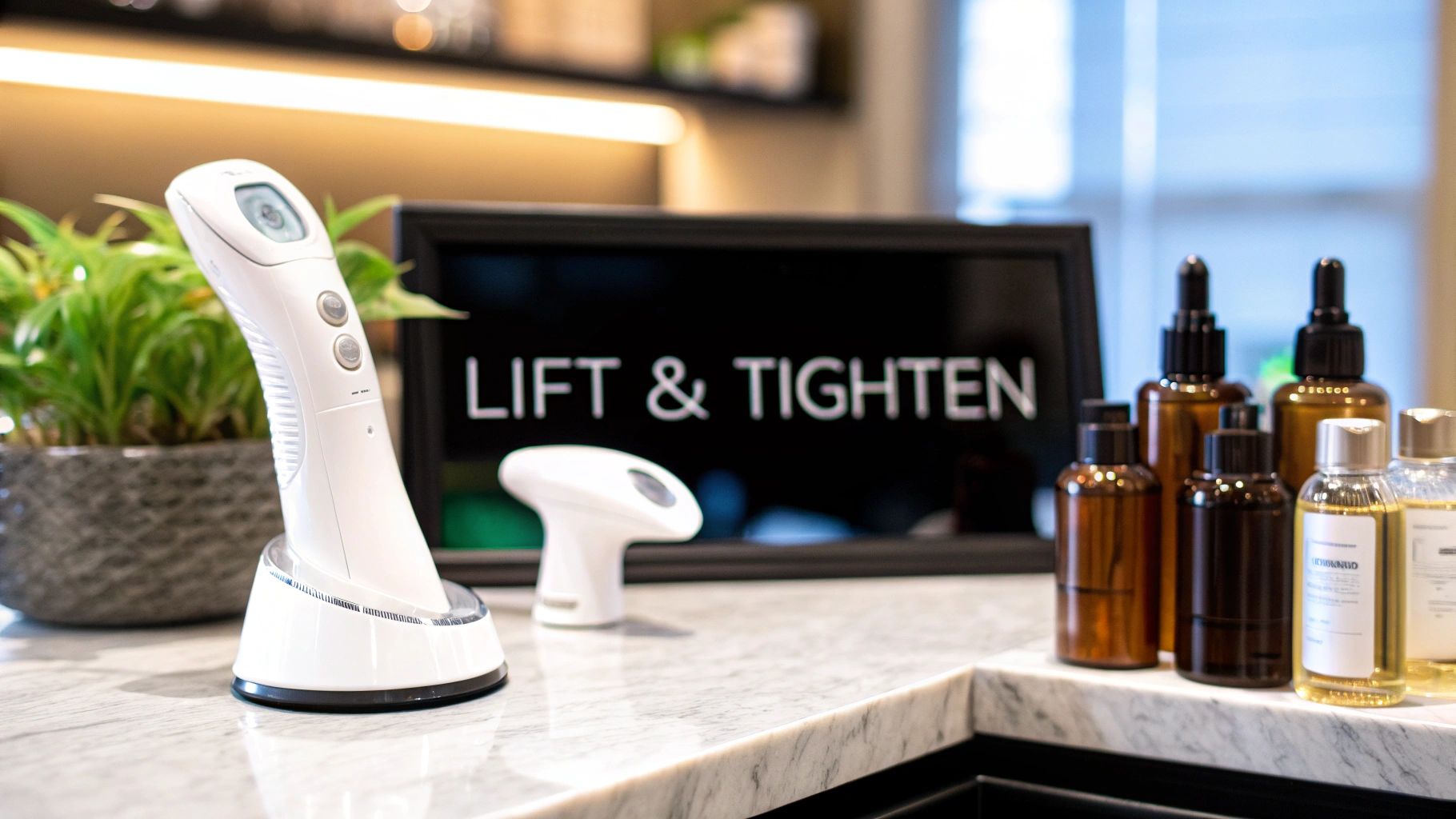
Skin sagging, a natural result of aging caused by the decline of collagen and elastin, is one of the most common aesthetic concerns. While foundational skincare plays a role, significant skin laxity often requires more advanced and targeted intervention. Fortunately, the options for addressing this have expanded dramatically, offering a sophisticated spectrum of solutions that go far beyond a traditional surgical facelift. Today's most effective approaches range from non-invasive energy devices that stimulate your body’s own renewal processes to minimally invasive procedures that deliver an immediate, visible lift.
This article serves as an in-depth roundup of the best treatments for sagging skin, meticulously breaking down the science, benefits, and ideal candidacy for each. We will explore everything from ultrasound and radiofrequency technologies to innovative injectable boosters and the gold-standard surgical options. For a comprehensive overview of various strategies and treatments available to combat skin laxity, you can explore this ultimate guide on how to tighten loose skin.
Our goal is to provide a clear, expert-backed roadmap, empowering you to navigate your choices with confidence. Whether you are aiming for subtle prevention or a more dramatic rejuvenation, this guide will help you understand the most powerful tools available for reclaiming a firmer, more youthful appearance.
Ultherapy stands out as one of the best treatments for sagging skin because it is the only FDA-cleared, non-invasive procedure that uses micro-focused ultrasound imaging to lift and tighten skin on the neck, chin, and brow. The technology allows practitioners to see the layers of tissue they are treating, ensuring the energy is delivered precisely where it will be most effective. This process triggers the body's natural regenerative response, stimulating the growth of new, fresh collagen.
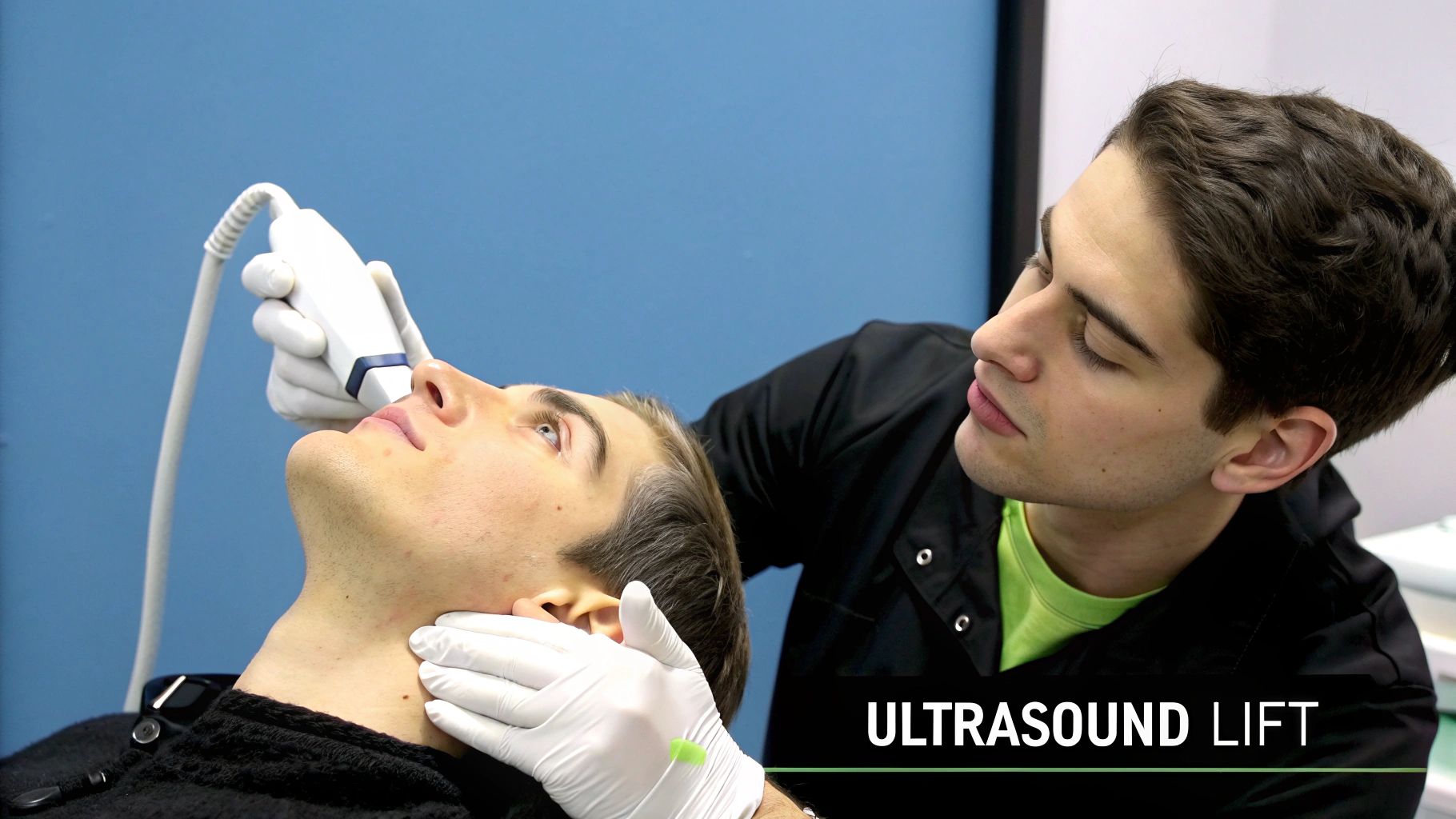
Unlike lasers, which penetrate the skin from the outside-in, Ultherapy bypasses the surface of the skin to deliver focused ultrasound energy at specific depths. It targets the same foundational layer (the SMAS) typically addressed in cosmetic surgery, but without any incisions or downtime. This makes it an excellent alternative for those not ready for a surgical facelift.
The procedure works by creating thermal coagulation points deep within the skin's structure. This controlled thermal effect kickstarts neocollagenesis, the process of producing new collagen. Over the next two to three months, this new collagen works to gradually lift and tighten the skin from within.
Ultherapy is best suited for individuals with mild to moderate skin laxity, where the skin has begun to feel and look less firm. It's a popular choice for patients in their 30s and older who are just starting to see signs of aging. Christie Brinkley has famously endorsed the treatment as part of her anti-aging regimen.
Pro Tip: Schedule your Ultherapy session 3-6 months before a major event like a wedding or reunion. This timeline allows the full, natural-looking results from new collagen growth to become visible. Also, consider taking an over-the-counter pain reliever like ibuprofen about an hour before your appointment to manage potential discomfort.
Radiofrequency (RF) skin tightening is another one of the best treatments for sagging skin, utilizing electromagnetic waves to gently heat the deep layers of your skin, known as the dermis. This controlled heating process, typically reaching between 122-167°F (50-75°C), causes an immediate contraction of existing collagen fibers. More importantly, it stimulates a powerful healing response that generates new collagen and elastin over time, leading to firmer, smoother, and more youthful-looking skin.
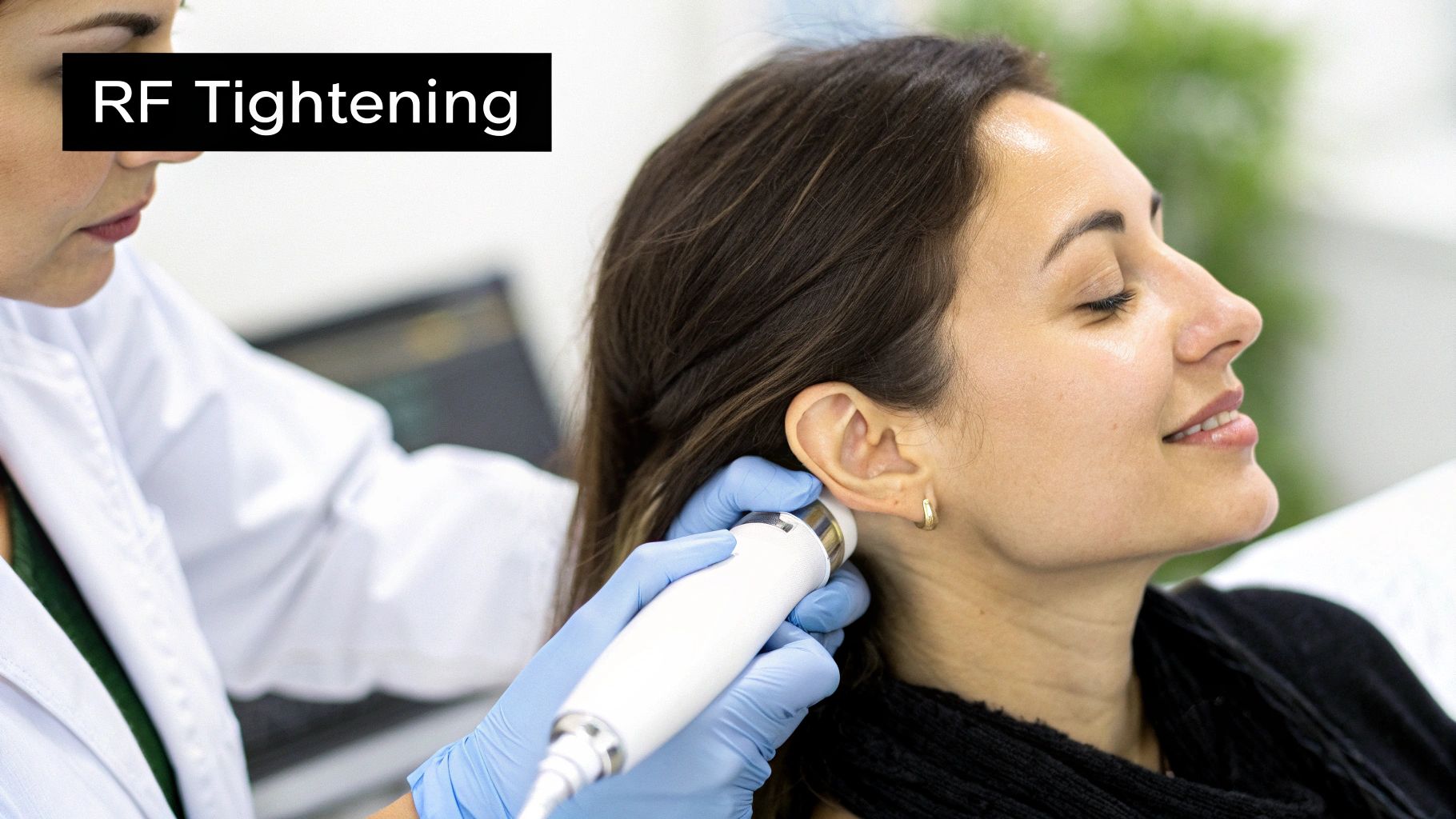
Unlike some other energy-based treatments, RF is generally safe for all skin tones as it targets deeper tissues without affecting the melanin in the skin's surface. A wide range of devices use this technology, from the well-known Thermage FLX to advanced microneedling combinations like Morpheus8. These options allow practitioners to customize the treatment for specific concerns, from delicate eye areas to the jawline and body.
The core mechanism of RF treatments is bulk heating of the dermis. This thermal energy triggers a dual-action response: instant tightening from collagen fiber contraction and long-term firming from neocollagenesis. The result is a gradual, natural-looking improvement in skin texture and laxity.
RF skin tightening is ideal for individuals with mild to moderate skin sagging who want to achieve noticeable firming without surgery. It is a popular choice for those looking to address early signs of aging, such as jowls, fine lines, and crepey skin texture. Celebrities like Kim Kardashian have helped popularize treatments like Morpheus8 for its impressive results. You can learn more about non-invasive skin tightening options to see if it's right for you.
Pro Tip: For optimal results, most RF treatments require a series of sessions spaced 4-6 weeks apart. Staying well-hydrated before and after your appointment can enhance the treatment's effectiveness. Since the results are highly dependent on the provider's skill, always seek an experienced, certified practitioner for your procedure.
A thread lift is a minimally invasive treatment that offers a subtle yet visible lift to sagging skin. It involves inserting temporary, medical-grade sutures made of biocompatible materials like polydioxanone (PDO), poly-L-lactic acid (PLLA), or polycaprolactone (PCL) under the skin. These threads anchor onto loose tissue, allowing a practitioner to mechanically lift and tighten the skin for an immediate rejuvenating effect.
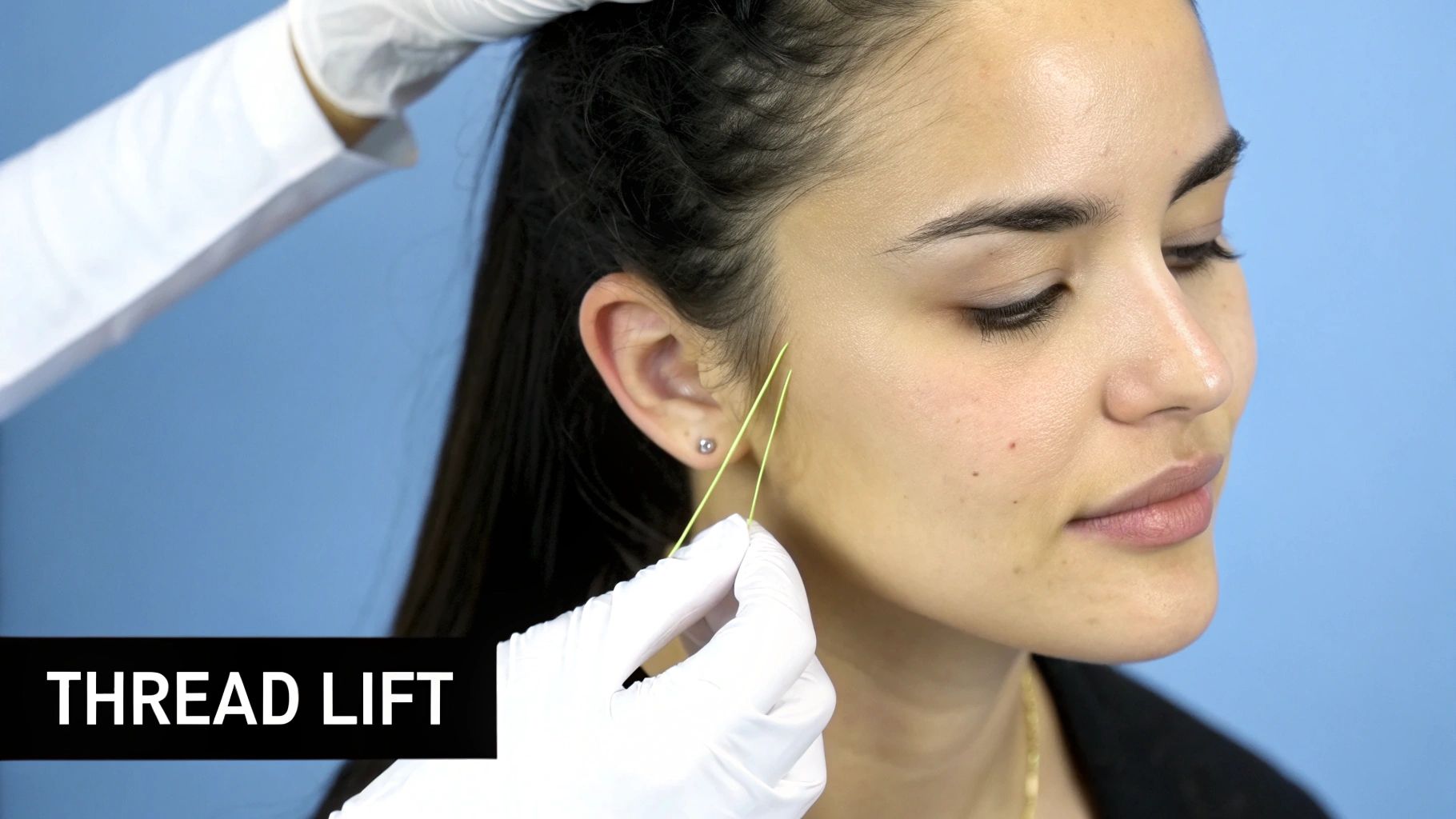
Often called a "lunchtime facelift," this procedure provides a dual benefit. Beyond the initial physical lift, the threads stimulate a controlled healing response, encouraging the body to produce new collagen in the treated areas. As the threads naturally dissolve over six to twelve months, this new collagen structure helps maintain skin firmness and volume, making it one of the best treatments for sagging skin that provides both instant and progressive results.
The procedure uses threads with different textures, such as barbed or coned, to grip the underside of the skin. Once inserted, they are gently pulled to reposition the skin and create a more defined, youthful contour. The collagen-stimulating properties of the threads further enhance skin quality over time.
A thread lift is an excellent option for individuals with mild to moderate skin laxity who are not yet ready for a surgical facelift. It is best suited for patients in their late 30s to early 50s who still have good skin quality and elasticity. Well-known procedures include the Silhouette InstaLift and NovaThreads.
Pro Tip: To ensure a smooth recovery, avoid strenuous exercise and excessive facial movements for about two weeks post-procedure. Sleeping with your head elevated on a couple of pillows for the first week can also help minimize swelling. You can learn more about PDO thread lifts and if they are right for you.
Injectable skin boosters are a unique category of treatments for sagging skin that work by stimulating the body's own regenerative capabilities. Rather than simply filling wrinkles, these products improve skin quality from within by triggering collagen production and deep hydration. This approach addresses skin laxity at a foundational level, leading to gradual, natural-looking firming and thickening of the skin over time.
Unlike traditional dermal fillers, biostimulators like Sculptra and Radiesse and bio-remodeling products like Profhilo don't offer immediate dramatic volume. Instead, their primary role is to act as a scaffold or signal for your body to create new collagen and elastin. This makes them one of the best treatments for sagging skin for individuals seeking global improvement in skin texture, firmness, and elasticity without altering facial contours drastically.
These injectables use different active ingredients to achieve a similar goal: neocollagenesis. Profhilo uses a high concentration of stabilized hyaluronic acid that spreads like honey beneath the skin to hydrate and remodel aging tissue. Sculptra and Radiesse use poly-L-lactic acid and calcium hydroxylapatite, respectively, which act as catalysts for long-term collagen synthesis.
Skin boosters are ideal for individuals experiencing early to moderate signs of aging, such as thinning skin, fine lines, and a loss of elasticity and "glow." They are perfect for patients who want a proactive treatment that improves overall skin health and provides subtle, progressive results. As noted by NYC plastic surgeon Dr. Lara Devgan, these treatments are a cornerstone of modern "prejuvenation" strategies.
Pro Tip: For Sculptra, follow the "5-5-5" rule: massage the treated areas for 5 minutes, 5 times a day, for 5 days. This ensures the product is distributed evenly and helps stimulate collagen. For all boosters, be patient, as the full tightening and volumizing effects can take 2-3 months to become apparent.
RF microneedling earns its spot among the best treatments for sagging skin by powerfully combining two proven technologies: microneedling and radiofrequency energy. This advanced procedure uses ultra-fine, insulated needles to create controlled micro-injuries in the skin while simultaneously delivering targeted radiofrequency heat deep into the dermis. This dual-action approach triggers an intensified collagen and elastin production response, addressing skin laxity, texture, and tone in one go.
Unlike traditional microneedling, which primarily targets the skin's surface, RF microneedling's energy is delivered directly to the deeper layers where collagen is formed. This allows for more significant and robust skin tightening with minimal damage to the outer skin layer. Devices like Morpheus8 and Profound RF allow practitioners to customize the needle depth (from 0.5mm to 4mm) and energy levels for precise treatment of various body areas.
The procedure's effectiveness comes from its two-part mechanism. The microneedles create tiny channels that prompt the body's natural healing cascade, while the RF energy heats the underlying tissue, causing existing collagen fibers to contract and stimulating the production of new, stronger collagen and elastin. This process, known as dermal remodeling, results in firmer, smoother, and more lifted skin over time.
RF microneedling is an excellent choice for individuals with mild to moderate skin laxity who also want to improve skin texture, fine lines, or acne scars. It is safe for most skin types and tones, as the RF energy bypasses the melanin-producing cells in the epidermis, reducing the risk of hyperpigmentation. Celebrities like Hailey Bieber and Kourtney Kardashian have openly shared their use of the treatment for maintaining firm, clear skin.
Pro Tip: Ensure your provider applies a strong topical numbing cream 45-60 minutes before the session for comfort. Plan for 3-5 days of redness and swelling, and avoid sun exposure, makeup, and active skincare ingredients for at least 48 hours post-treatment. For best results, a series of 3-4 treatments spaced 4-6 weeks apart is typically recommended.
The surgical facelift, or rhytidectomy, remains the undisputed gold standard among treatments for sagging skin, offering the most dramatic and long-lasting results. It is the definitive solution for individuals with moderate to severe skin laxity who desire a comprehensive rejuvenation. The procedure involves surgically lifting and repositioning the underlying muscles and tissues (the SMAS layer), removing excess skin, and re-draping the remaining skin for a smoother, more youthful contour.
Unlike non-invasive options that stimulate collagen, a facelift physically restructures the foundational elements of the face. Incisions are discreetly placed within the hairline and around the natural contours of the ear, minimizing visible scarring. Modern techniques championed by surgeons like Dr. Andrew Jacono have refined the procedure to produce exceptionally natural-looking outcomes that can last for 10 to 15 years.
A facelift provides a powerful, multi-layered approach to facial rejuvenation by addressing the root causes of sagging, not just the surface-level symptoms. The results are immediate, although they are initially obscured by swelling and bruising.
A surgical facelift is best for healthy individuals, typically in their 50s and older, with significant age-related changes like deep facial folds, jowling, and extensive skin laxity that non-surgical treatments cannot adequately correct. Actress Jane Fonda has been famously open about her decision to have a facelift to help her look as vibrant as she feels.
Pro Tip: Your surgeon's skill is paramount. Thoroughly research board-certified plastic surgeons and review extensive before-and-after portfolios of their work. Plan for a significant recovery period of 2-3 weeks away from work and social activities, and arrange for help at home during the first week. Sleeping with your head elevated on pillows is crucial to minimizing swelling.
Topical treatments are the cornerstone of any effective skincare regimen aimed at preventing and treating mild sagging skin. Among these, retinoids and growth factors are powerful ingredients that provide a non-invasive, long-term solution. Retinoids, which are derivatives of vitamin A, are renowned for their ability to accelerate skin cell turnover and stimulate collagen synthesis, making them a gold standard for improving skin firmness. Growth factors are naturally occurring proteins that signal cells to repair and rejuvenate, promoting the production of essential collagen and elastin.
When used consistently, this potent combination represents one of the best at-home treatments for sagging skin, gradually improving texture and resilience. While the results are more subtle and take longer to appear than in-office procedures, they are foundational for maintaining skin health and structure.
Retinoids work by binding to receptors in skin cells, which in turn boosts the production of collagen, strengthens the epidermis, and enhances skin elasticity. Growth factors complement this process by providing the signaling molecules that direct cells to create the structural proteins that keep skin firm and youthful.
This infographic provides a quick reference for what to expect when starting these powerful topicals.
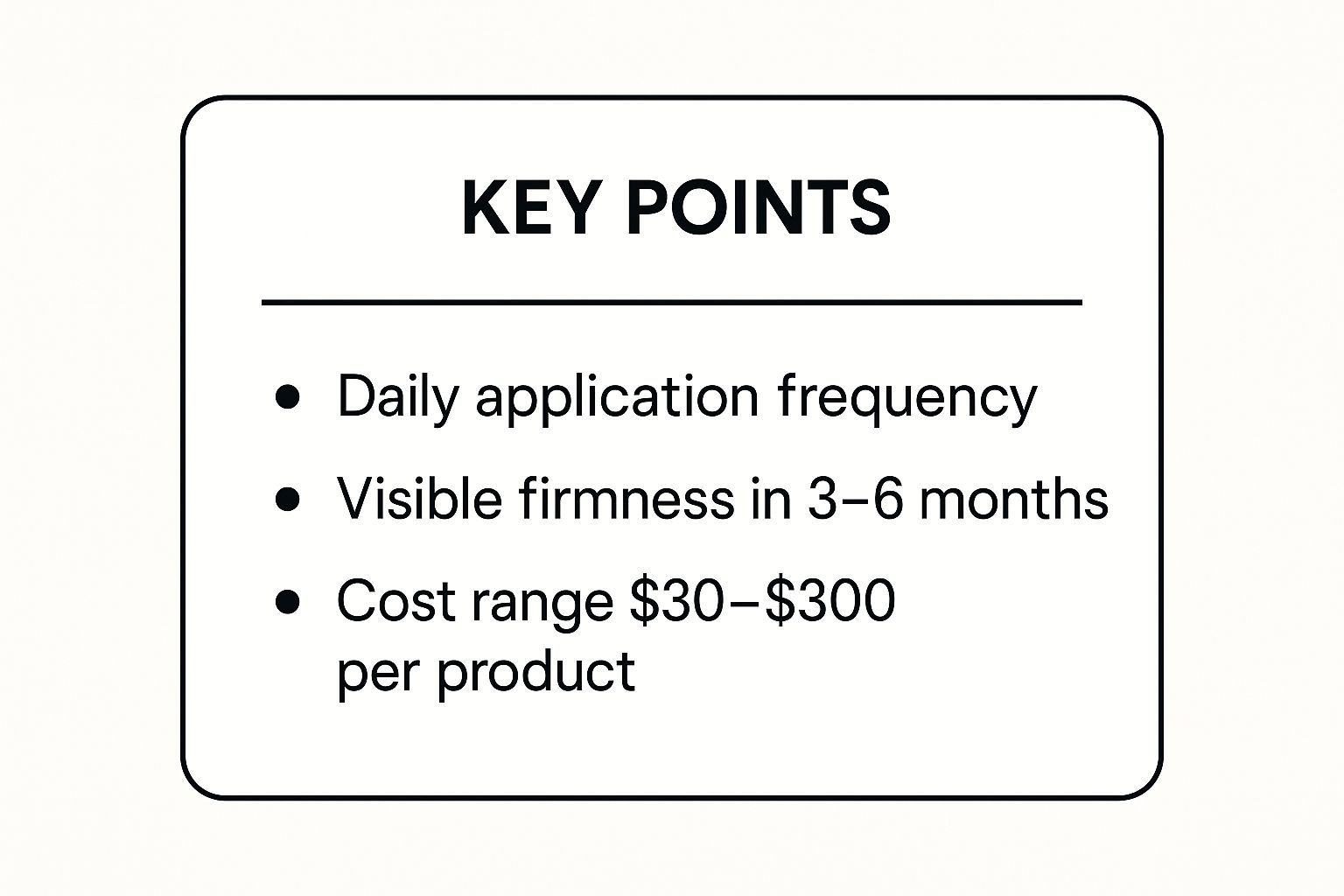
As the data shows, consistency is crucial, as visible improvements in firmness can take three to six months to become apparent.
Topical treatments are ideal for anyone looking to proactively address the initial signs of skin laxity or to complement the results of professional procedures. They are suitable for individuals in their late 20s and beyond who want to invest in the long-term health of their skin. Understanding the potency and application of prescription-strength retinoids is key; refer to a detailed Adapalene vs Tretinoin guide for more information on choosing the right one.
Pro Tip: Start low and go slow with retinoids. Apply a pea-sized amount to dry skin only two to three times a week, gradually increasing to nightly use as tolerated. Always follow with a moisturizer to minimize irritation and apply a broad-spectrum SPF 50+ every morning, as retinoids increase sun sensitivity.
Laser skin resurfacing is a highly effective treatment for sagging skin because it uses concentrated beams of light energy to remove damaged outer skin layers while heating the underlying dermis. This dual action causes immediate collagen contraction for a tightening effect and stimulates long-term new collagen production. The result is smoother, firmer, and more youthful-looking skin, making it one of the best treatments for sagging skin available.
Fractional lasers, like the Fraxel Repair or Sciton Halo, are a modern advancement. They create microscopic treatment columns in the skin, leaving surrounding tissue untouched. This approach promotes much faster healing and reduces downtime compared to traditional fully ablative lasers, which treat the entire surface area.
The procedure works by delivering precise thermal energy to the skin. This controlled injury removes old, sun-damaged cells and triggers a powerful healing response in the deeper layers. As the skin repairs itself, it rebuilds its collagen and elastin matrix, leading to significant improvements in laxity.
Laser skin resurfacing is ideal for individuals with mild to moderate skin laxity who also want to address concerns like wrinkles, sun damage, and uneven texture. Those with lighter skin tones are often better candidates, as there is less risk of pigmentation changes. A consultation with a laser expert like Dr. Rebecca Fitzgerald is essential to determine if a CO2 or a gentler Erbium laser is right for you. Learn more about how laser skin resurfacing transforms skin texture on ccplasticsurgery.com.
Pro Tip: Prepare your skin for 4-6 weeks beforehand with a retinoid to enhance results and speed up healing. Always schedule your laser treatment during the fall or winter, when you can more easily avoid direct sun exposure, and be prepared to use a high-quality SPF 50+ daily for at least three months post-procedure.
Navigating the diverse landscape of aesthetic treatments can feel overwhelming, but understanding the spectrum of available options is the first step toward reclaiming a firmer, more youthful appearance. Throughout this guide, we've explored the most effective solutions, from non-invasive energy devices to the definitive results of surgical intervention. The key takeaway is that there is no single "best" treatment for sagging skin for everyone; instead, the ideal approach is a highly personalized one, tailored to your specific needs.
For those just beginning to notice a loss of elasticity or seeking preventative measures, non-invasive treatments like Ultherapy and Radiofrequency (RF) skin tightening offer a powerful way to stimulate collagen production with little to no downtime. Similarly, a dedicated at-home regimen featuring high-potency topical retinoids and growth factors provides the essential foundation for maintaining skin health and resilience.
As skin laxity becomes more moderate, a different set of tools becomes more effective. Minimally invasive procedures represent a significant step up in impact, offering a middle ground between surface-level treatments and full surgery.
When sagging is more significant, surgical options provide the most dramatic and long-lasting correction. A surgical facelift remains the gold standard for comprehensively repositioning underlying tissues and removing excess skin, effectively turning back the clock in a way non-surgical methods cannot replicate. Likewise, laser skin resurfacing offers profound textural renewal, smoothing wrinkles and tightening the skin's surface for a truly polished result.
Ultimately, choosing the best treatment for sagging skin is a collaborative process. Your decision should be guided by your aesthetic goals, tolerance for downtime, budget, and, most importantly, the expert recommendation of a qualified professional. A thorough consultation is not just a preliminary step; it is the most critical component of your journey. An experienced practitioner can assess the unique characteristics of your skin and facial anatomy to design a customized plan that ensures your results are not only beautiful but also safe and natural-looking.
Ready to explore your personalized path to firmer, rejuvenated skin? Dr. Marc Fater and the expert team at Cape Cod Plastic Surgery specialize in creating customized treatment plans, from non-invasive technologies to advanced surgical techniques. Schedule your consultation today at Cape Cod Plastic Surgery to discover which of the best treatments for sagging skin is right for you.

November 26, 2025
Learn how to get rid of jowls without surgery with natural treatments, exercises, and skincare tips that actually work.

November 25, 2025
how much botox costs explained: learn what affects pricing, average ranges, and tips to save on your treatment.
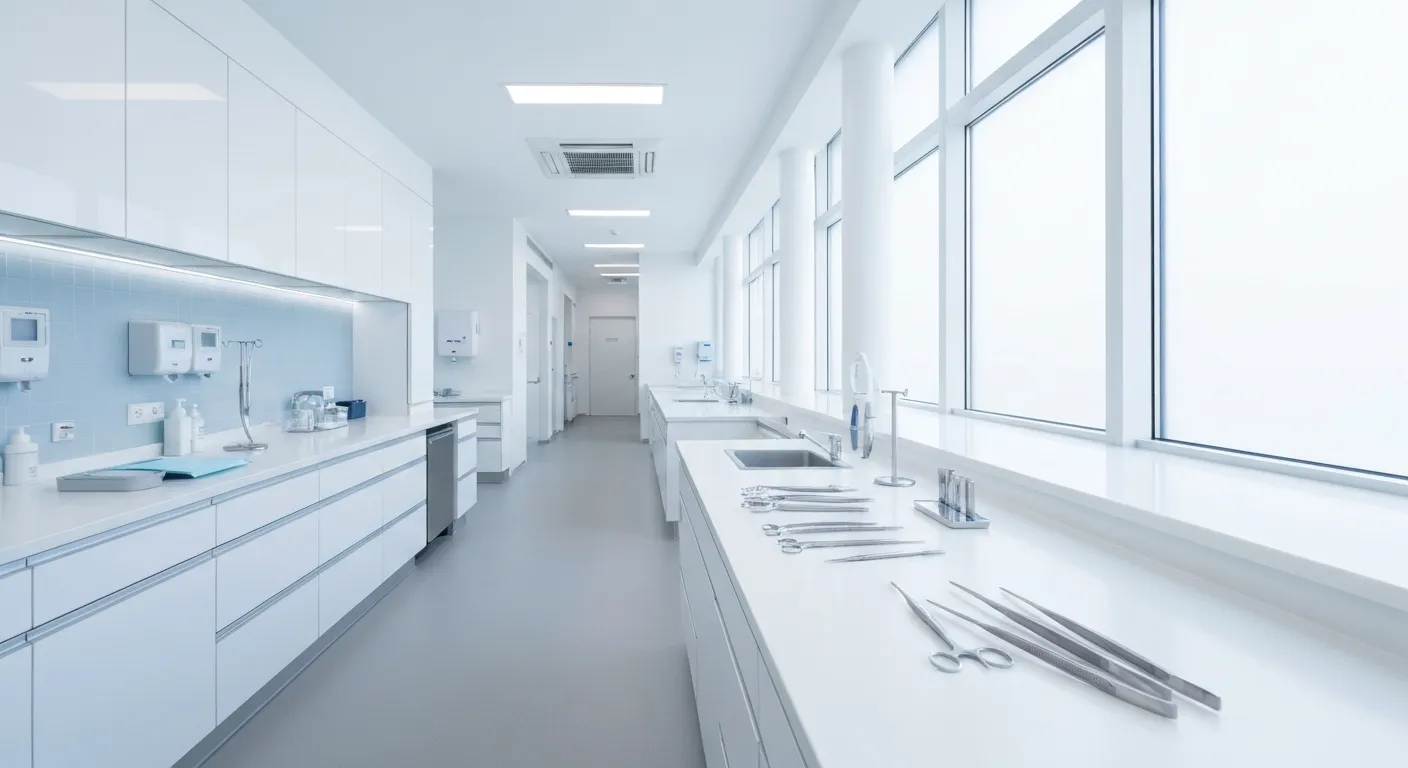
November 25, 2025
Understanding Key Insights and Facts About Plastic Surgery